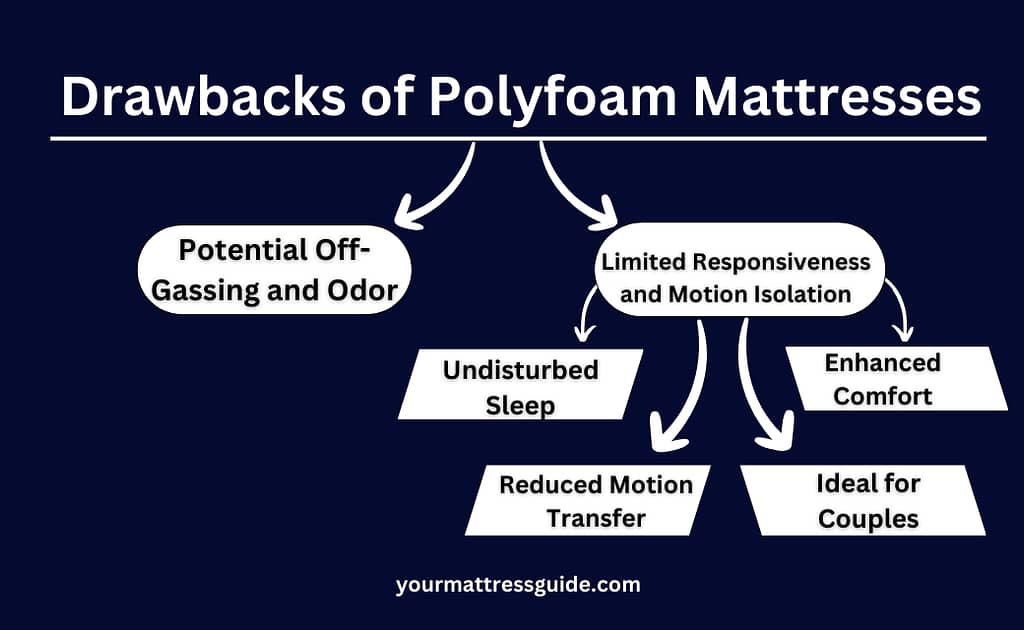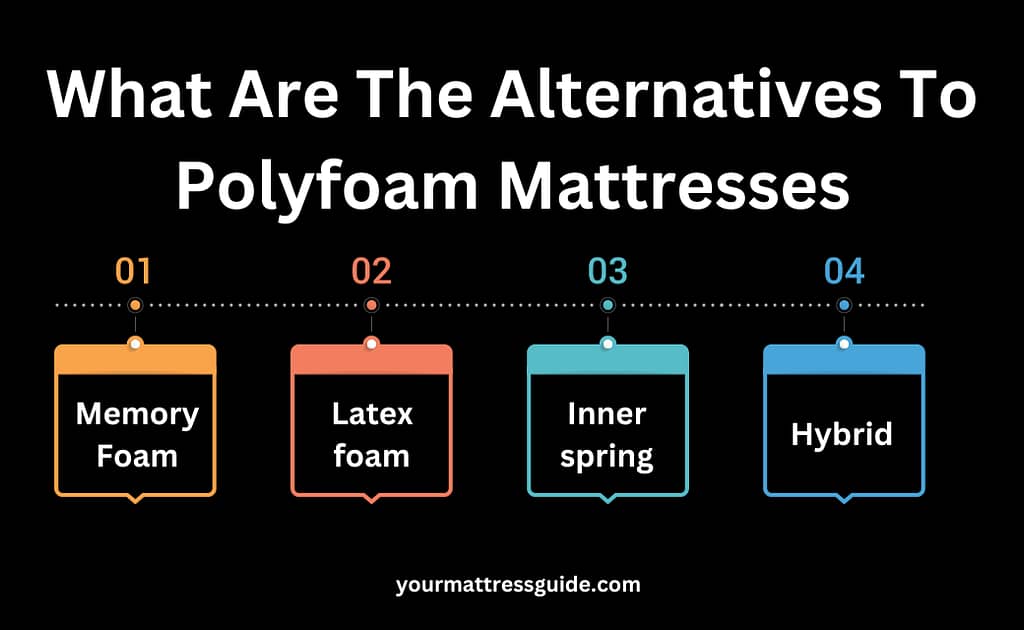Polyurethane foam, the material used to make a polyfoam mattress, is well-known for its supportive and comfy characteristics. You can fall into a comfortable night’s sleep on one of these mattresses thanks to its medium firmness level, which also helps your body stay in its natural sleeping position.
Among the many advantages of polyfoam mattresses are their long lifespan, resilience, and superior pressure relief and motion isolation capabilities. Some possible downsides are off-gassing and poor temperature regulation.
Considering the density, thickness, and existence of extra comfort layers of the foam is essential when selecting a polyfoam mattress. Memory foam and latex are additional options if you’re flexible with your mattress shopping.
Based on your newfound knowledge about the material, You may decide if a polyfoam mattress is the best option for your sleep needs.

What Is A Polyfoam Mattress Understanding Polyurethane Foam Material
One of the most used mattress materials is polyurethane foam, sometimes called polyfoam, because of its many valuable properties.
This particular foam comes by mixing various chemicals, including polyols and isocyanates. The resulting foam is highly breathable thanks to its open-cell structure. This aids in temperature regulation and keeps you from getting too hot as you sleep.
As it molds to your body, polyfoam alleviates pressure points and lessens the possibility of pain and stiffness, making it an ideal pressure reliever. Its reputation for longevity also makes it an investment worth making.
Polyurethane foam is an excellent option for a long-lasting, comfortable, supportive, breathable, and high-quality mattress.
What Are The Benefits of Polyfoam Mattresses?
Get a good night’s sleep on a polyfoam bed and feel renewed energy when you open your eyes. There are many advantages to sleeping on a polyfoam mattress.
First and foremost, polyfoam is an excellent pressure reliever; it will cradle your body and make you feel much better. It molds to your body’s curves, so your spine stays natural and you’re less likely to wake up sore.
A polyfoam mattress’s well-known motion isolation features make it ideal for couples who want to sleep undisturbed by a fidgety bedmate. In addition to being long-lasting, they will keep their form and provide support for many years.
For individuals who suffer from asthma or allergies, polyfoam mattresses are an excellent option due to their hypoallergenic and resistance to mildew, dust mites, and other allergens.
And lastly, if you’re looking for a great mattress at a reasonable price, go no further than polyfoam. A polyfoam mattress is an excellent investment that will improve your quality of sleep.
What Are the Drawbacks of Polyfoam Mattresses?
You need to be aware of several downsides to polyfoam mattresses. Some people may be allergic to the fragrances they release when they off-gas, so that’s something to keep in mind.
As a second point, you can wake up feeling your partner’s motion all night long on a polyfoam mattress because of its poor reactivity and motion isolation.
Finally, you can compromise the comfort and support of polyfoam mattresses due to their tendency to droop with time.
Potential Off-Gassing and Odor
On the first night of sleeping on your new polyfoam mattress, you may notice a distinct odor that may take a while due to off-gassing.
The reason is that VOCs can be emitted by synthetic materials used to make polyfoam mattresses. The smell comes from these volatile organic compounds (VOCs), which can irritate the respiratory system or trigger allergic reactions in some people.
Before using your mattress, let it air out in an adequately ventilated space for a few days to reduce off-gassing and odor. In addition to preventing odors and accidents, the protector or cover can extend the life of your mattress.
Limited Responsiveness and Motion Isolation
You may sleep well on this mattress without getting bothered by your partner’s motion because of its low reactivity and excellent motion isolation. The four main advantages of this feature are as follows:
- Undisturbed Sleep: The motion-absorbing properties of the polyfoam mattress make it ideal for use in motion-sensitive sleep environments. This will ensure your companion can’t keep you up at night with their restless nights.
- Enhanced Comfort: Because it isn’t very responsive, the mattress will mold to your shape, making it ideal for relieving pressure and supporting your body. A warm embrace of serenity will envelop you.
- Reduced Motion Transfer: You won’t notice if your companion gets up several times at night or switches positions often. You won’t feel any disturbance because the mattress blocks out movements.
- Ideal for Couples: If you and your spouse sleep at different times or have different tastes in mattresses, this one will change the game. Rest easy, knowing your partner’s movements won’t disturb your slumber.

What Is A Polyfoam Mattress Prone to Sagging Over Time
Your polyfoam mattress’s support and comfort have no guarantee if it begins to sag with time. The density of polyfoam mattresses is often lower than that of other foam mattresses. Its reduced density, particularly in high-pressure situations, makes it more likely to compress and indent.
When the foam in your mattress degrades and becomes less resilient, you could feel like you’re sinking into the bed rather than being supported. Discomfort and disturbed sleep may result from this.
Turning and flipping your mattress frequently to avoid or reduce sagging is essential. A mattress’s long-term durability and support may be better assured by purchasing a higher-density polyfoam mattress or exploring alternative varieties of foam mattresses.
Factors to Consider When Choosing a Polyfoam Mattress
There are a few things to remember when shopping for a polyfoam bed. Consider the foam’s density first. Durability and support are two areas where higher-density foam shines.
- The next thing to consider is the level of firmness you desire. Mattress firmness is subjective; some people like it soft, and some want it firmer.
- The foam’s thickness is another critical factor to consider. In most cases, you get better support and cushioning with thicker foam.
- You should also consider the mattress cover. Find a cover that lets air in and is simple to wash.
- Last but not least, think about the warranty and pricing. Ensure the mattress is within your price range and has a solid warranty covering all the bases.
Finding a polyfoam mattress that works for you and lets you sleep well is possible if you keep these things in mind.
What Are The Alternatives to Polyfoam Mattresses?
If you’re tired of your current mattress and want something new, many different materials can give you a good night’s sleep. Some options to think about instead of polyfoam mattresses are:
- Memory foam: By molding to your every curve, this material offers superior support and alleviates pressure areas.
- Latex foam: Naturally breathable, long-lasting, and responsive, latex foam is produced from the sap of rubber plants.
- Innerspring: A layer of foam or padding, which uses a network of coils for support, is typically placed on top of these mattresses.
- Hybrid: Hybrid mattresses combine the greatest qualities of innerspring and foam to provide you with the best of both worlds.

Every option has unique qualities that can help you get a good night’s sleep. When deciding on the ideal mattress, consider your wants and tastes.
Final Words
To sum up, polyurethane foam is the material of choice for a polyfoam mattress. Pressure alleviation, motion isolation, and cost are some of its benefits. The downsides, including off-gassing and durability concerns, are not without their consequences.
Thickness, density, and hardness are three things to consider when buying a polyfoam bed. Also, consider memory foam, latex, or a hybrid mattress as an alternative. When it comes down to it, everyone has different comfort and support requirements when shopping for a mattress.
FAQs
How long does a polyfoam mattress typically last?
Your mileage on a polyfoam mattress may vary from 5 to 10 years due to variations in quality and use. Rotate it often if you want it to last as long as possible and keep working correctly.
Can a polyfoam mattress be used on an adjustable bed frame?
An adaptable bed frame is suitable for a polyfoam mattress. Its adaptability means it can fit snugly around your frame, giving you the perfect support and relaxation as you slumber.
Are polyfoam mattresses safe for individuals with allergies or sensitivities?
In most cases, people allergic to or sensitive to latex can sleep soundly on a polyfoam mattress. They withstand mold and dust mites and are hypoallergenic. But before you buy a mattress, make sure it won’t aggravate your allergies by researching the materials used to make it.
How does the price of a polyfoam mattress compare to other mattress types?
Compared to more expensive materials like latex or memory foam, polyfoam mattresses are more budget-friendly. The exact cost, however, will vary with factors like brand, quality, and features of the mattress in question.


